
A NOAA aircraft flying through the eye of a hurricane.
Ken Heystek gained plenty of experience maintaining and flying on Lockheed P-3 Orion aircraft during his 21-year career with the U.S. Navy, but never during that time were those aircraft being flown directly into a storm system. Now, as a maintenance controller at the National Oceanic and Atmospheric Administration (NOAA), he works on P-3s that are heading straight into hurricanes.
Heystek is part of NOAA’s Hurricane Hunters team, which operates a fleet of three aircraft through intense storms to collect data that helps hurricane researchers better understand and predict storm behavior. He has worked onboard NOAA’s Lockheed Martin WP-3D Orion aircraft as a flight engineer, controlling air speed and monitoring engines in flight during these daunting missions. He compares the experience of these flights to “riding a roller coaster while riding a mechanical bull.”
“It throws you around a little bit, and you get bumped and tossed around, but it’s constant work,” Heystek says. The aircraft typically make four passes through a hurricane to collect data in each quadrant, such as measurements of pressure, humidity, temperature, wind direction and speed. Depending on the size of the storm, each pass can take between five and 45 min. to get through the eyewall. Each flight typically takes about 8 hr. to complete.
“It’s just constant coordination between the pilots and flight engineer to maintain airspeed, try to keep the wings level and get us through,” he says. “Then we get a short break when we get through the eye, and it’s beautiful. You’ll look up and see the Sun, and you’ll look down and the waters will be calm. You get a couple minutes to enjoy it before you’re right back in because you have to go out the other side.”
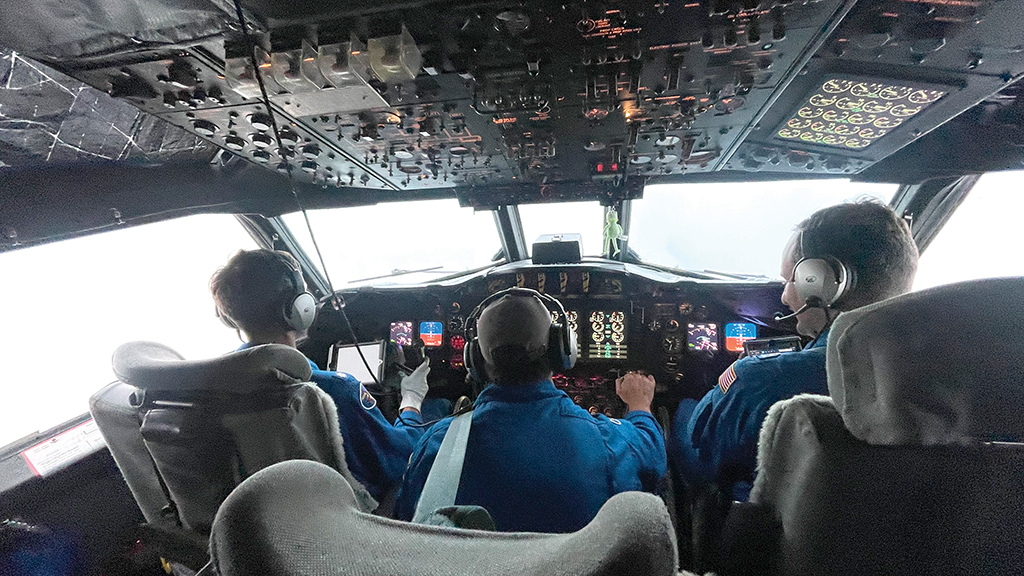
While this type of wild ride sounds scary, Heystek says the Hurricane Hunter team’s experience and dedication provide reassurance. “I wouldn’t call it stressful, and I never thought I was close to losing my life. We’ve got experienced crews and we train them very well. Our planes handle these sorts of things very well,” he says.
One such crewmember is Lt. Commander Danielle Varwig, who serves as NOAA’s Aircraft Operations Center maintenance officer and pilots the team’s Gulfstream IV-SP aircraft. “It’s one of those things where, when you go through flight school, it’s what everyone says you’re not supposed to do,” she says. “We’re the ones that are going straight toward the bad weather. It’s anxiety-inducing, but knowing the support team and training that we have to complete before we do our first hurricane flight puts me at ease.”
A normal flight crew for the Hurricane Hunters is typically between nine and 11 people, including three pilots and two flight engineers who rotate out every couple of hours for breaks. They also include a flight director (meteorologist), a navigator, an airborne vertical atmospheric profiling station operator and a scientific systems analyst who operates the aircraft’s data systems. Occasionally, VIP passengers and members of the media are on these flights as well.
While the flight crew are all well-versed in flying these unique missions, Varwig says many special considerations are needed to maintain safety. “Aside from the obvious dangers that come with the severe weather, for us it’s lightning possibility, severe turbulence or loss of aircraft performance,” she notes. “The higher up you go, the less the engines are able to perform at the speeds we want to fly. We lose that capability to remain airborne at a certain point in time. There are a lot of added elements we have to take into consideration, and we do that via risk management.”
This includes preflight weather briefings by the team’s inflight meteorologists to identify all hazards the team may face in the air. NOAA’s maintenance team on the ground also performs preflight and postflight inspections that are much more technical than average. Preflight inspections typically take about 2 hr., and postflight inspections typically take about 1 hr. However, the pressure to turn aircraft around quickly is high, according to Austin Roche, an aerospace technician with the Hurricane Hunters team who conducts hands-on maintenance on its Gulfstream and Lockheed aircraft.
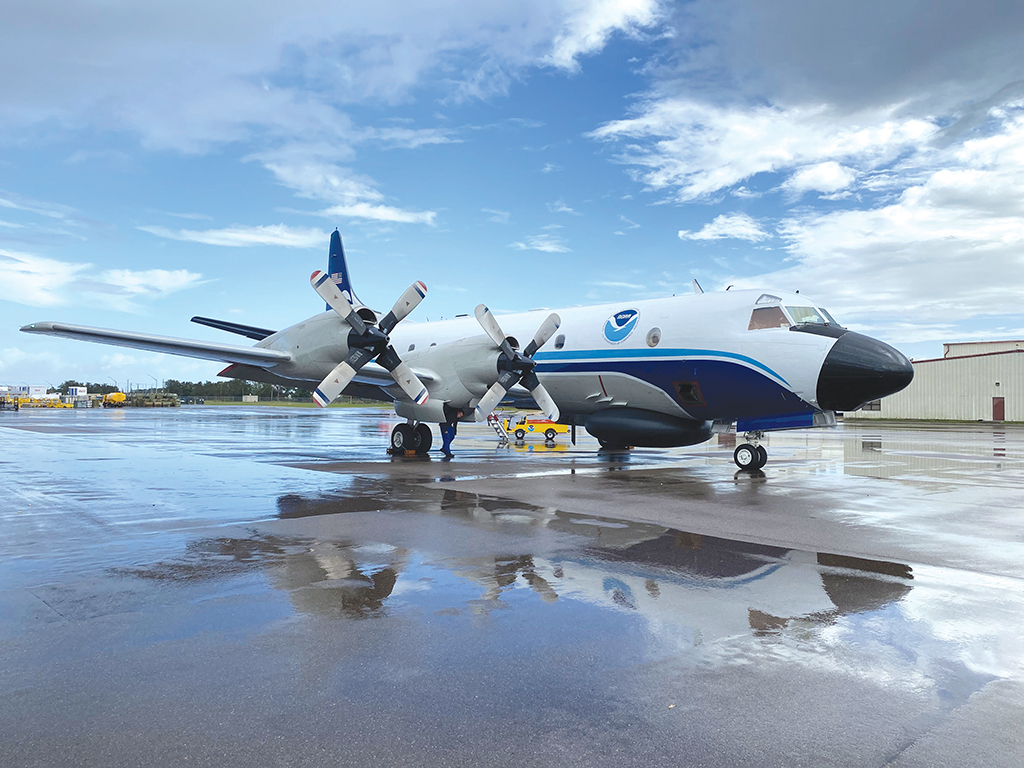
“During hurricane season, the schedule can be kind of chaotic,” he says. “We predict as much as we can when a hurricane is coming, but [regardless of] if it’s night or day, we’re flying basically 24-hr. operations when we can to try to get all the data we can to the hurricane center. On the maintenance side of things, the tempo is pretty high. When the plane lands, we’re doing everything we can to make sure tires are serviced and all inspections are done. If we have a seven-day outlook for a hurricane, we can knock out everything we possibly can during those seven days so we don’t have to worry about it in the future. For normal day-to-day, it’s pretty average, and we’re doing normal inspections.”
At the start of a typical week, the maintenance team conducts a seven-day inspection that includes opening engine cowls to inspect the powerplants internally. At 52-week intervals, the team performs deeper-phase inspections, which include more detailed work such as removing panels and inspecting floorboards. The aircraft also receive five-year inspections in which they are fully overhauled. This includes tearing down all parts and conducting major corrosion inspections to look for cracks and perform nondestructive testing on the aircraft skin and spars.
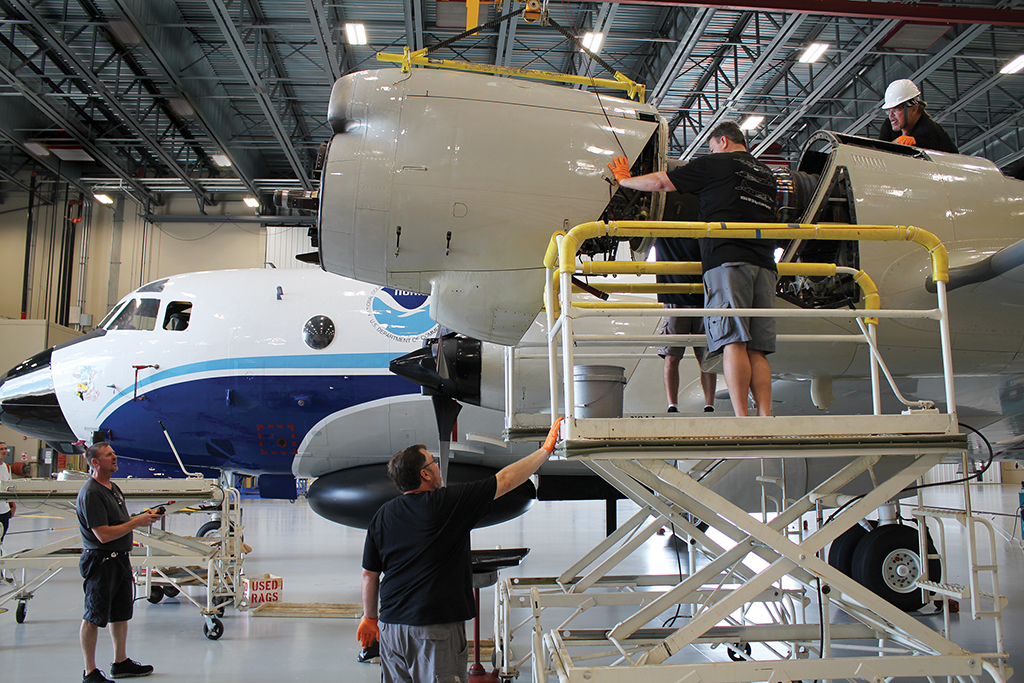
The Hurricane Hunters’ P-3 aircraft are approaching 50 years of age, and their Gulfstream is nearly 30 years old. The fleet’s age means things break more often. NOAA is in the process of acquiring newer aircraft to replace the P-3s, which are set to retire in 2030. It is awaiting approved funding to order C-130J aircraft.
“As these aircraft age, maintaining them is a little more difficult,” Heystek says. “Things that never break are now starting to break. ” Varwig points to an incident during a recent flight: “Toward the end of this past hurricane season, one of our P-3s had a maintenance issue while they were in a hurricane, which was crazy. They were able to fly out of it [with] no problem and still got the mission done miraculously but essentially limped the aircraft back home.”
Heystek notes that if anything breaks during flight, the crew onboard will try to fix it so they do not have to abort the mission. Once the aircraft has safely landed, the maintenance team takes over. “The aircraft are a lot older, so you can’t plug them into a computer and have it tell you what to do. We actually have to troubleshoot when things go wrong,” he says.
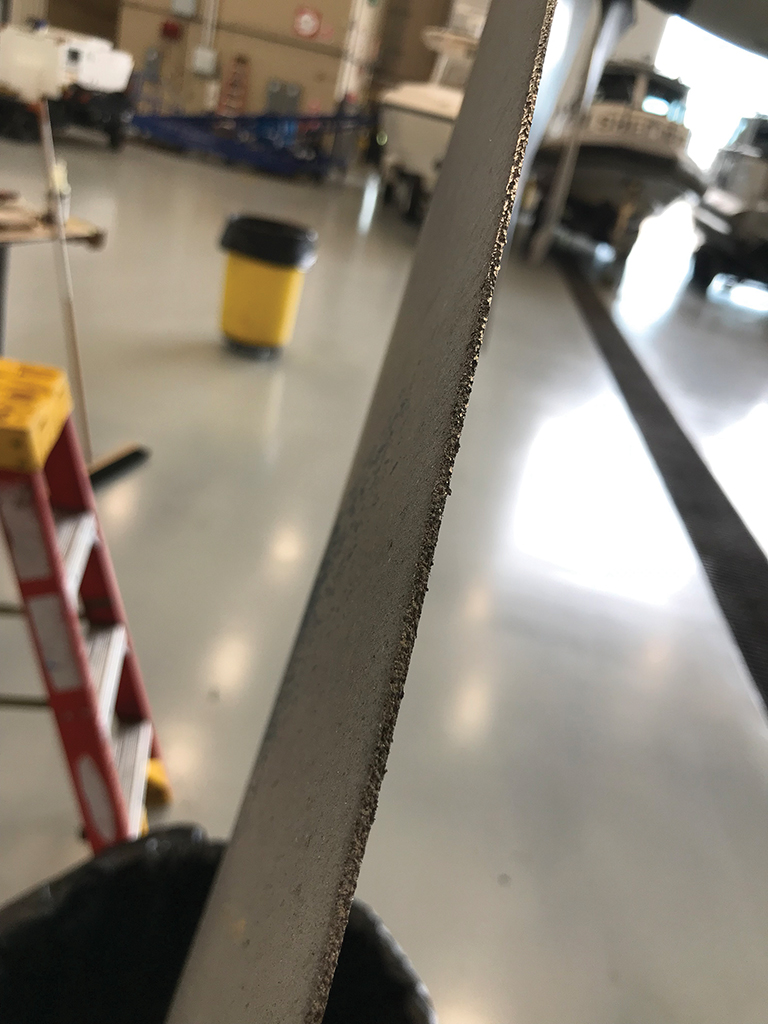
Flying through hurricanes also causes increased wear and tear on the aircraft. “They take on a tremendous amount of water, which does two things,” Heystek explains. “It does damage to the props, but it also roughs up the leading edges. It’s very challenging between flights, especially after a strong storm, because we have to turn it around and get ready for the next day or the next crew that’s coming in, depending on how many aircraft we have flying through the storm at one time.”
Cracks that need to be repaired often are found during the fleet’s frequent inspection regimen. “We do a bunch of blade blending and keep our props in tip-top shape or they will get cracks,” Roche says.
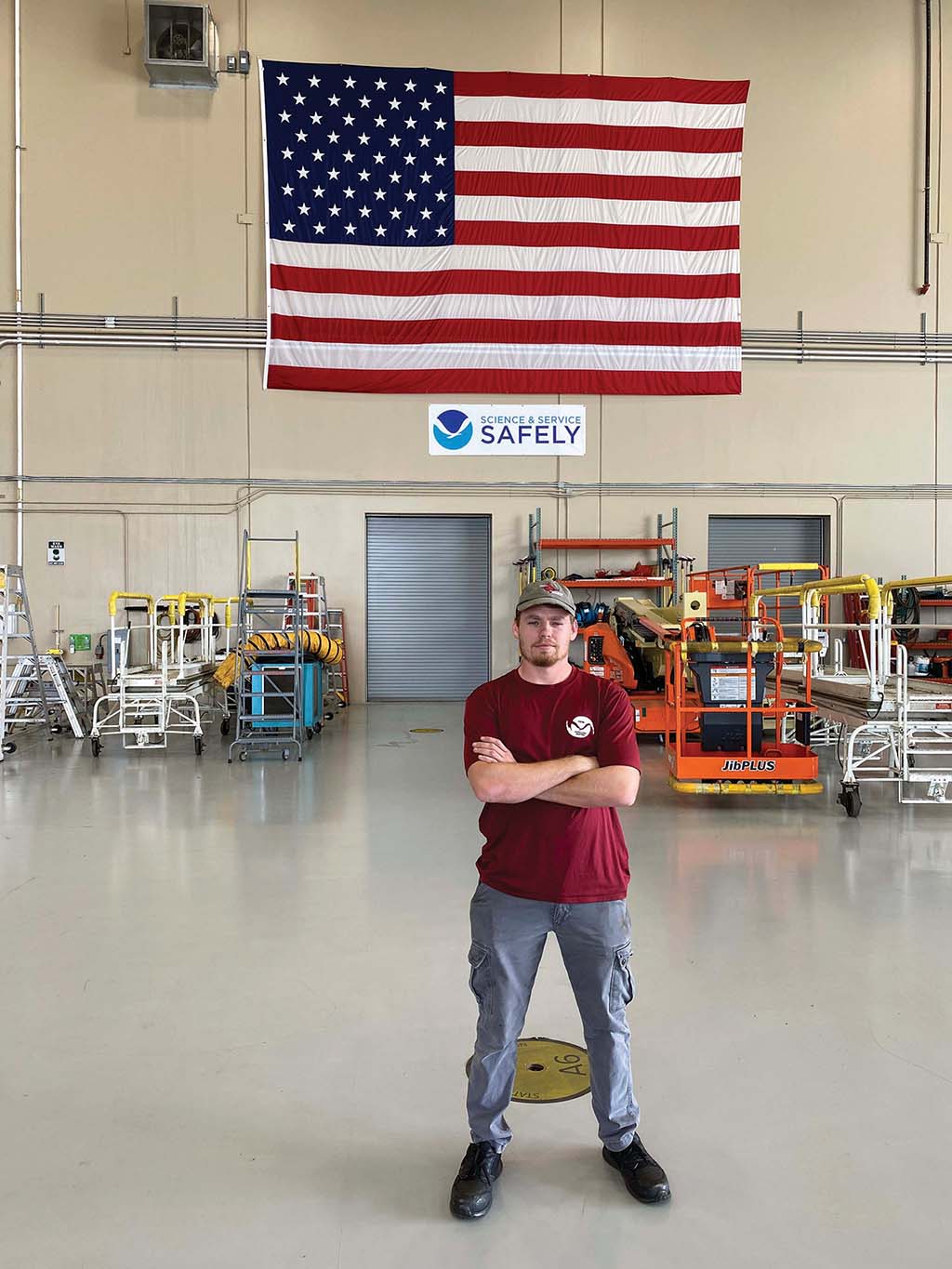
“One of the biggest things is that we cannot keep our props painted. We paint them, and we can make them look pretty, but after one hurricane flight, the paint is basically gone,” he continues. “When we get the time in between flights, we do try to touch up paint when we can.”
Despite their unique mission, the aircraft do not have many special features—at least on the outside. “Believe it or not, both aircraft aren’t beefed up like people would think,” Roche says. “They don’t have any special shielding or anything like that. We have special radars on them and special systems to read the weather and read the storms when we fly through them. We also have special inspections for those systems.”
NOAA’s team performs much of the integration for these special systems in-house, leveraging sheet metal technicians and aerospace engineers who help install systems on the aircraft.
Most maintenance takes place at NOAA’s 156,043-ft.2 hangar facility at Lakeland Linder International Airport in Florida, where it has two hangars. The larger hangar houses the Hurricane Hunters aircraft, but the facility also includes a supply department that stocks parts as well as a light hangar for NOAA’s four De Havilland Canada DHC-6 Twin Otters and two Beechcraft King Air 350 CERs. NOAA is scheduled to receive a third King Air 350 CER this summer. The Twin Otters are used to assist NOAA’s research for marine protected species surveys and remote sensing, while the King Airs conduct coastal mapping and snow survey missions.
Ordering parts not already in stock can be tricky, as they can take anywhere from a couple hours to a week to arrive. Varwig serves as a liaison between the maintenance and finance teams to procure all the necessary parts and equipment.
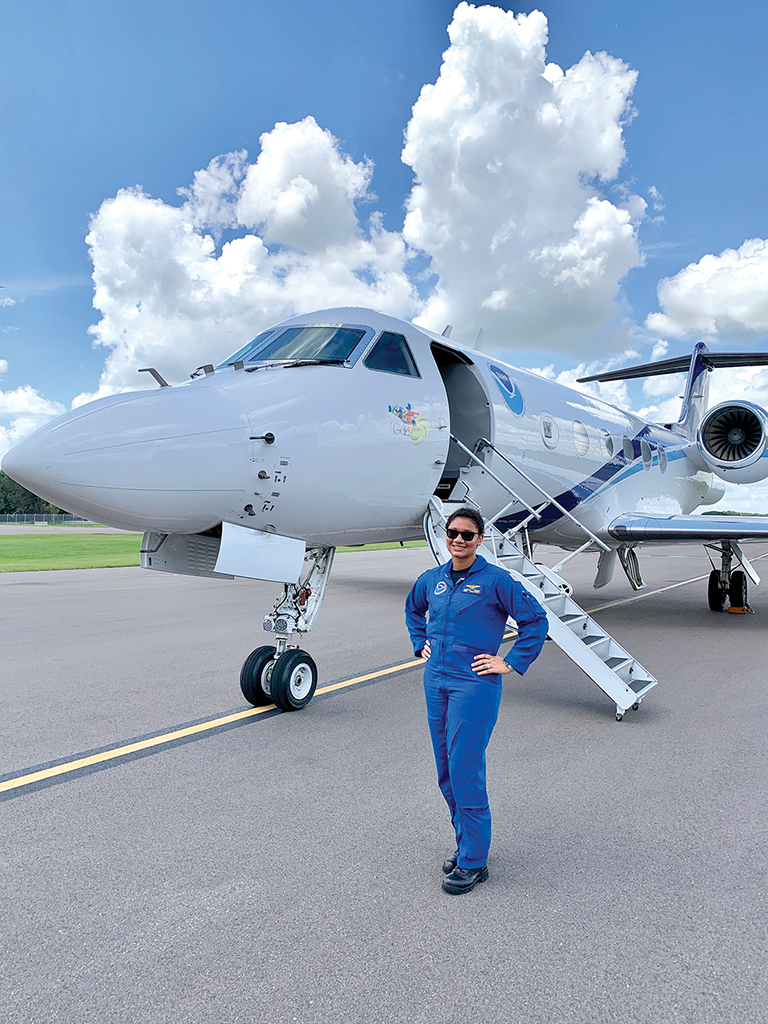
“Sometimes we have to beg, borrow and steal,” she jokes. “The good thing is that aircraft maintenance is always really high-priority. If we say this part or service creates an (aircraft-on-ground) situation where [the aircraft] can no longer fly, especially during hurricane season, the money comes flying toward us. Everyone understands the importance of the mission, and everyone trusts what our maintenance team is doing and what we need to keep aircraft flying in support of the mission.”
The maintenance team also must prepare for maintenance operations when on the road. In addition to the namesake mission of the Hurricane Hunters team, it also performs other missions throughout the U.S. “When people think of the Hurricane Hunters, all they can really think about is that we go to a hurricane, fly through it, and we don’t do anything else the rest of the year, but that’s not true,” Roche says.
The team went to Alaska to work on its Ocean Winds project, which entails flying over storms in the northern Pacific Ocean to help calibrate the wind speed measurements from satellites. It also is performing some sea ice research to help calibrate differences in measurements of ice between satellites and its own aircraft instruments.
NOAA’s Gulfstream aircraft is involved in the Atmospheric Rivers project as well, flying at high altitude above weather systems approaching the West Coast to sample the amount of water in each system. The aim is to predict how much water ideally should be stored in California’s reservoirs to prevent flooding and tackle droughts.
NOAA sends maintenance team members along for these missions to support the aircraft, so advance planning is required to prepare the tools and equipment that will be needed. “We use pack-outs and have a lot of spare parts. We have a master list we bring with us to predict what might fail while we’re over there,” Roche says. “We bring tire-change kits, any data test sets that we might need and anything for scheduled inspections that might pop up while we’re in that environment.”
Outside of hurricane season, NOAA keeps its maintenance team busy. “If we’re not flying a project or flying hurricane missions, we’re off to training,” Roche says. “I’m about to go to prop school for our P-3s to learn how to take them apart, rebuild them and perform troubleshooting. Every school we go to makes us better mechanics for servicing the aircraft.”
While NOAA’s team performs much of its maintenance in-house, it also receives support from some fixed-base operators and L3Harris Technologies’ maintenance facility in Waco, Texas, where in-depth maintenance is performed during phase inspections.
NOAA is seeking to expand its Hurricane Hunters team as it grows its fleet, too. Varwig says the team is looking for people who are willing to go the extra mile for NOAA’s unique mission. Since the maintenance teams travel and interact with other mechanics as well as flight crews, meteorologists, engineers and scientists, teamwork is very important.
“When I was in the military, one of the big things about aviation maintenance was attention to detail,” Roche notes. “Aviation is an industry where every screw counts. It all takes a team—including pilots, air crew and maintenance—to work together to keep the planes airborne and get people to where they need to go safely.
“As a Hurricane Hunter, that has increased my level of attention. Flying through a hurricane, where anything could go wrong at any time, we have to be on top of our game. We are at 110% all the time. We work with our engineers and our flight directors to get these missions done, and it takes a team, even on the maintenance side.”
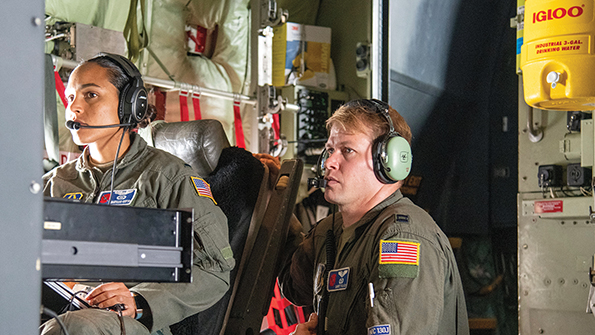
Aviation Week's Own Hurricane Hunter
When he’s not supporting Aviation Week’s Aircraft Bluebook as an aircraft valuations analyst, Garrett Black serves as a captain with the U.S. Air Force’s 403rd Wing, a Hurricane Hunters team based out of Keesler AFB. He spoke with Lindsay Bjerregaard about his experience flying on the squadron’s Lockheed WC-130J aircraft.
How did you end up flying with the Air Force Hurricane Hunters, and what is your role with the team?
Before joining the Hurricane Hunters in the Reserves, I was working with the Air Force on the Air National Guard side doing Army weather support. My degree is in meteorology, so jumping over to the Hurricane Hunters was a pretty smooth transition.
My role with the Hurricane Hunters is aerial reconnaissance weather officer. I act as a mission director onboard when we fly into hurricanes to collect data for the National Hurricane Center. My job is to quality-check and make sure we get what we need in the hurricane while also keeping the aviation piece in mind.
What is it like flying into a hurricane?
Every storm is entirely different. Oftentimes, stronger storms end up being a little bit smoother than you’d expect and vice versa. We definitely get lightning, turbulence, and sometimes there’s even occasional hail we fly through.
One of the most memorable flights I’ve had from an intensity standpoint was Hurricane Dorian as it was making landfall on the Bahamas. It was a very strong Category 5 storm, and I remember the views because we were there for sunrise in the eye. It was a perfect stadium effect where the eyewall clouds were vertical all around us with a very clear eye, so it was very picturesque. It was a humbling experience because it was really beautiful, but you also knew how strong it was and the damage it was doing. The second most memorable flight was probably Hurricane Ian last year right before it made landfall on the coast of Florida. It ended up being an extremely bumpy flight that definitely made things challenging. It was probably the most severe turbulence I’ve experienced in a hurricane.
How do Hurricane Hunters aircraft differ from regular C-130Js?
The WC-130J is not modified. Besides some of our weather instruments, the actual airframe is that of a typical C-130J. Structurally, it’s just a very durable, tough aircraft that is kind of a tank in the air, and it can handle a multitude of different missions and environments.
What has been your favorite part about being a Hurricane Hunter?
It’s just a great way to truly know that you’re out there helping people. It’s such a unique opportunity to be able to fly through a hurricane. To be able to do that but also collect such vital data that’s going to the National Hurricane Center and then being disseminated to people who are potentially in harm’s way is very unique, and it makes me very proud to be able to do that.
